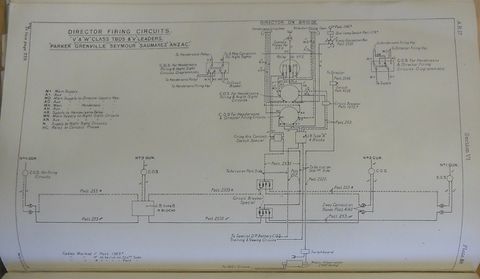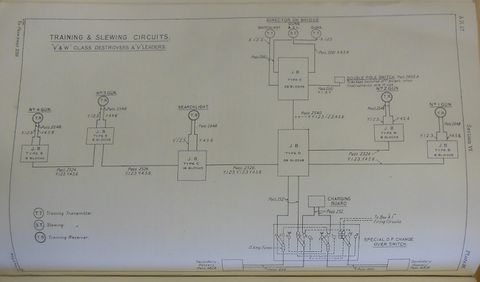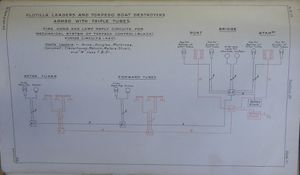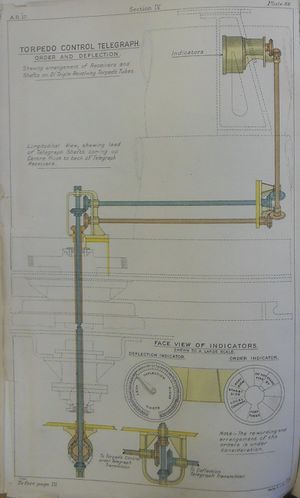"W" Class Destroyer (1917): Difference between revisions
No edit summary |
|||
| (17 intermediate revisions by 2 users not shown) | |||
| Line 18: | Line 18: | ||
|- align=left | |- align=left | ||
| {{Template:UK-Wakeful}} | | {{Template:UK-Wakeful}} | ||
|[[John Brown]] | |[[John Brown & Company]] | ||
| | | | ||
|6 Oct, 1917 | |6 Oct, 1917 | ||
| Line 25: | Line 25: | ||
|- align=left | |- align=left | ||
| {{Template:UK-Watchman}} | | {{Template:UK-Watchman}} | ||
|[[John Brown]] | |[[John Brown & Company]] | ||
| | | | ||
|2 Nov, 1917 | |2 Nov, 1917 | ||
| Line 32: | Line 32: | ||
|- align=left | |- align=left | ||
| {{Template:UK-Walpole}} | | {{Template:UK-Walpole}} | ||
|[[Doxford]] | |[[William Doxford & Sons]] | ||
| | | | ||
|12 Feb, 1918 | |12 Feb, 1918 | ||
| Line 39: | Line 39: | ||
|- align=left | |- align=left | ||
| {{Template:UK-Whitley}} | | {{Template:UK-Whitley}} | ||
|[[Doxford]] | |[[William Doxford & Sons]] | ||
| | | | ||
|13 Apr, 1918 | |13 Apr, 1918 | ||
| Line 46: | Line 46: | ||
|- align=left | |- align=left | ||
| {{Template:UK-Walker}} | | {{Template:UK-Walker}} | ||
|[[Denny]] | |[[William Denny & Brothers]] | ||
| | | | ||
|29 Nov, 1917 | |29 Nov, 1917 | ||
| Line 53: | Line 53: | ||
|- align=left | |- align=left | ||
| {{Template:UK-Westcott}} | | {{Template:UK-Westcott}} | ||
|[[Denny]] | |[[William Denny & Brothers]] | ||
| | | | ||
|14 Feb, 1918 | |14 Feb, 1918 | ||
| Line 60: | Line 60: | ||
|- align=left | |- align=left | ||
| {{Template:UK-Walrus}} | | {{Template:UK-Walrus}} | ||
|[[Fairfield]] | |[[Fairfield Shipbuilding and Engineering Company]] | ||
| | | | ||
|27 Dec, 1917 | |27 Dec, 1917 | ||
| Line 67: | Line 67: | ||
|- align=left | |- align=left | ||
| {{Template:UK-Wolfhound}} | | {{Template:UK-Wolfhound}} | ||
|[[Fairfield]] | |[[Fairfield Shipbuilding and Engineering Company]] | ||
| | | | ||
|14 Mar, 1918 | |14 Mar, 1918 | ||
| Line 74: | Line 74: | ||
|- align=left | |- align=left | ||
| {{Template:UK-Warwick}} | | {{Template:UK-Warwick}} | ||
|[[Hawthorn Leslie]] | |[[Hawthorn Leslie & Company]] | ||
| | | | ||
|28 Dec, 1917 | |28 Dec, 1917 | ||
| Line 81: | Line 81: | ||
|- align=left | |- align=left | ||
| {{Template:UK-Wessex}} | | {{Template:UK-Wessex}} | ||
|[[Hawthorn Leslie]] | |[[Hawthorn Leslie & Company]] | ||
| | | | ||
|12 Mar, 1918 | |12 Mar, 1918 | ||
| Line 88: | Line 88: | ||
|- align=left | |- align=left | ||
| {{Template:UK-Voyager}} | | {{Template:UK-Voyager}} | ||
|[[ | |[[Alexander Stephen & Sons]] | ||
| | | | ||
|8 May, 1918 | |8 May, 1918 | ||
| Line 109: | Line 109: | ||
|- align=left | |- align=left | ||
| {{Template:UK-Winchelsea}} | | {{Template:UK-Winchelsea}} | ||
|[[J. | |[[J. Samuel White]] | ||
| | | | ||
|15 Dec, 1917 | |15 Dec, 1917 | ||
| Line 116: | Line 116: | ||
|- align=left | |- align=left | ||
| {{Template:UK-Winchester}} | | {{Template:UK-Winchester}} | ||
|[[J. | |[[J. Samuel White]] | ||
| | | | ||
|1 Feb, 1918 | |1 Feb, 1918 | ||
| Line 123: | Line 123: | ||
|- align=left | |- align=left | ||
| {{Template:UK-Westminster}} | | {{Template:UK-Westminster}} | ||
|[[ | |[[Scotts Shipbuilding and Engineering Company]] | ||
| | | | ||
|1918 | |1918 | ||
| Line 130: | Line 130: | ||
|- align=left | |- align=left | ||
| {{Template:UK-Windsor}} | | {{Template:UK-Windsor}} | ||
|[[ | |[[Scotts Shipbuilding and Engineering Company]] | ||
| | | | ||
|21 Jun, 1918 | |21 Jun, 1918 | ||
| Line 137: | Line 137: | ||
|- align=left | |- align=left | ||
| {{Template:UK-Wryneck}} | | {{Template:UK-Wryneck}} | ||
|[[Palmer]] | |[[Palmer Shipbuilding and Iron Company]] | ||
| | | | ||
|13 May, 1918 | |13 May, 1918 | ||
| Line 144: | Line 144: | ||
|- align=left | |- align=left | ||
| {{Template:UK-Waterhen}} | | {{Template:UK-Waterhen}} | ||
|[[Palmer]] | |[[Palmer Shipbuilding and Iron Company]] | ||
| | | | ||
|26 Mar, 1918 | |26 Mar, 1918 | ||
| Line 151: | Line 151: | ||
|- align=left | |- align=left | ||
| {{Template:UK-Wolsey}} | | {{Template:UK-Wolsey}} | ||
|[[Thornycroft]] | |[[John I. Thornycroft & Company]] | ||
| | | | ||
|16 Mar, 1918 | |16 Mar, 1918 | ||
| Line 158: | Line 158: | ||
|- align=left | |- align=left | ||
| {{Template:UK-Woolston}} | | {{Template:UK-Woolston}} | ||
|[[Thornycroft]] | |[[John I. Thornycroft & Company]] | ||
| | | | ||
|27 Apr, 1918 | |27 Apr, 1918 | ||
| Line 169: | Line 169: | ||
===4-in Guns=== | ===4-in Guns=== | ||
* Four 4-in Q.F. Mark V guns on {{Mount|C.P. II|UK}}s{{UKDirectorFiringDestroyers1918|p. 55}} | |||
===Other Guns=== | ===Other Guns=== | ||
===Torpedoes=== | ===Torpedoes=== | ||
* Two | |||
* Two [[21-in T.R. Mark I Torpedo Tube (UK)|21-in T.R. Mark I tubes]] (2x3){{ARTS1917|p. 210}} | |||
This new mounting inaugurated the triple tube format for the Royal Navy, offering destroyers three times the ready torpedo numbers of destroyers designed just six years previously..{{ARTS1917|p. 76, 77}} | |||
In mid-1920, it was ordered that [["S" Class Destroyer (1918)|"S"]], [["V" Class Destroyer (1917)|"V"]] and "W" class destroyers should be allocated the {{Torp|21-in Mark IV*|UK}}.{{ARTS1920|pp. 6-7. (G. 10141/20-6.8.1920)}} | |||
==Fire Control== | ==Fire Control== | ||
| Line 180: | Line 186: | ||
Experiments from February with two Grand Fleet destroyers employing [[Dumaresq|dumaresqs]] and [[Vickers Range Clock]]s and voicepipes showed definite advantages over ships using unaided spotting and voicepipes, even when the crews had no special training in the new equipment. Tests were also conducted to find a rangefinder suitable to the lively and cramped platform that destroyers provided. This led to an order on 3 April, 1916 that each T.B.D. of "M" class and later should be equipped with:{{UKTH23|p. 31}}{{UKProgressInNavalGunnery1914-1918|p. 35}} | Experiments from February with two Grand Fleet destroyers employing [[Dumaresq|dumaresqs]] and [[Vickers Range Clock]]s and voicepipes showed definite advantages over ships using unaided spotting and voicepipes, even when the crews had no special training in the new equipment. Tests were also conducted to find a rangefinder suitable to the lively and cramped platform that destroyers provided. This led to an order on 3 April, 1916 that each T.B.D. of "M" class and later should be equipped with:{{UKTH23|p. 31}}{{UKProgressInNavalGunnery1914-1918|p. 35}} | ||
* one [[Waymouth-Cooke Rangefinder|Waymouth-Cooke sextant rangefinder]] | * one [[Waymouth-Cooke Rangefinder|Waymouth-Cooke sextant rangefinder]] | ||
* one [[Vickers Clock]] | * one [[Vickers Range Clock]] | ||
* one Dumaresq | * one Dumaresq | ||
* range and deflection receivers at each gun | * range and deflection receivers at each gun | ||
| Line 192: | Line 198: | ||
[[File:ARTS1917Plate101.jpg|thumb|480px|'''Training and Slewing Circuits'''{{ARTS1917|Plate101}}]] | [[File:ARTS1917Plate101.jpg|thumb|480px|'''Training and Slewing Circuits'''{{ARTS1917|Plate101}}]] | ||
In 1917, it was approved that the "V" class and later destroyers should all receive installations of the [[British Destroyer Director Firing System]],{{ARTS1917|p. 229}} but none of these installations were completed prior to 1918.{{UKProgressInNavalGunnery1914-1918|p. 37}} | In 1917, it was approved that the "V" class and later destroyers should all receive installations of the [[British Destroyer Director Firing System]],{{ARTS1917|p. 229}} but none of these installations were completed prior to 1918.{{UKProgressInNavalGunnery1914-1918|p. 37}} | ||
The ''Director Firing Handbook, 1917'' reports that they were to receive [[Small Type Training Receiver]]s of pattern number 20 on #1, #2 guns, and pattern number 21 on #3 and #4.{{DirectorH|p. 146}} | |||
On 26 April, 1918, {{UK-Wolsey}} had her director tilt tested at Southampton.{{UKDirectorFiringDestroyers1918|p. 45}} | On 26 April, 1918, {{UK-Wolsey}} had her director tilt tested at Southampton.{{UKDirectorFiringDestroyers1918|p. 45}} | ||
| Line 200: | Line 208: | ||
* a fire gong push on fore bridge to be added, wired in parallel to that in the T.S. | * a fire gong push on fore bridge to be added, wired in parallel to that in the T.S. | ||
* the repeat receivers on the fore bridge were to be positioned so as to be visible to the director sightsetter. | * the repeat receivers on the fore bridge were to be positioned so as to be visible to the director sightsetter. | ||
===Rangefinders=== | |||
By 1921, all four-gun destroyers mounted a 1m [[F.T. 27]] RF on a [[M.H. 37]] mounting or a 9ft [[F.Q. 2]] on an [[M.Q. 12]] mount on their fore bridge.{{HRFs1921|p. 168}} | |||
==Torpedo Control== | ==Torpedo Control== | ||
| Line 211: | Line 222: | ||
==See Also== | ==See Also== | ||
{{refbegin}} | |||
{{WP|http://en.wikipedia.org/wiki/V_and_W_class_destroyer}} | {{WP|http://en.wikipedia.org/wiki/V_and_W_class_destroyer}} | ||
{{refend}} | |||
==Footnotes== | ==Footnotes== | ||
| Line 245: | Line 258: | ||
name=Wakeful | name=Wakeful | ||
pend=F.37 (Jan 1918){{DittColl|p. 73}} | pend=F.37 (Jan 1918){{DittColl|p. 73}} | ||
builder=[[John Brown]]{{Conways1906|p. 84}} | builder=[[John Brown & Company]]{{Conways1906|p. 84}} | ||
order=December, 1916{{Conways1906|p. 84}} | order=December, 1916{{Conways1906|p. 84}} | ||
laid= | laid= | ||
| Line 269: | Line 282: | ||
name=Walpole | name=Walpole | ||
pend=F.15 (Sep 1918){{DittColl|p. 73}} | pend=F.15 (Sep 1918){{DittColl|p. 73}} | ||
builder=[[Doxford]]{{Conways1906|p. 84}} | builder=[[William Doxford & Sons]]{{Conways1906|p. 84}} | ||
order=" | order=" | ||
laid= | laid= | ||
| Line 293: | Line 306: | ||
name=Walker | name=Walker | ||
pend=G.22 (Jan 1918)<br>G.08 (Apr 1918){{DittColl|p. 73}} | pend=G.22 (Jan 1918)<br>G.08 (Apr 1918){{DittColl|p. 73}} | ||
builder=[[Denny]]{{Conways1906|p. 84}} | builder=[[William Denny & Brothers]]{{Conways1906|p. 84}} | ||
order=" | order=" | ||
laid= | laid= | ||
| Line 315: | Line 328: | ||
name=Walrus | name=Walrus | ||
pend=G.17 (Apr 1918){{DittColl|p. 73}} | pend=G.17 (Apr 1918){{DittColl|p. 73}} | ||
builder=[[Fairfield]]{{Conways1906|p. 84}} | builder=[[Fairfield Shipbuilding and Engineering Company]]{{Conways1906|p. 84}} | ||
order=" | order=" | ||
laid= | laid= | ||
| Line 339: | Line 352: | ||
name=Warwick | name=Warwick | ||
pend=H.38 (Apr 1918)<br>''none'' (Sep 1918){{DittColl|p. 73}} | pend=H.38 (Apr 1918)<br>''none'' (Sep 1918){{DittColl|p. 73}} | ||
builder=[[Hawthorn Leslie]]{{Conways1906|p. 84}} | builder=[[Hawthorn Leslie & Company]]{{Conways1906|p. 84}} | ||
order=" | order=" | ||
laid= | laid= | ||
| Line 365: | Line 378: | ||
name=Voyager | name=Voyager | ||
pend=G.36 (Jun 1918){{DittColl|p. 73}} | pend=G.36 (Jun 1918){{DittColl|p. 73}} | ||
builder=[[ | builder=[[Alexander Stephen & Sons]]{{Conways1906|p. 84}} | ||
order=" | order=" | ||
laid= | laid= | ||
| Line 402: | Line 415: | ||
name=Winchelsea | name=Winchelsea | ||
pend=F.40 (Apr 1918){{DittColl|p. 73}} | pend=F.40 (Apr 1918){{DittColl|p. 73}} | ||
builder=[[J. | builder=[[J. Samuel White]]{{Conways1906|p. 84}} | ||
order=" | order=" | ||
laid= | laid= | ||
| Line 424: | Line 437: | ||
name=Westminster | name=Westminster | ||
pend=F.02 (Apr 1918){{DittColl|p. 73}} | pend=F.02 (Apr 1918){{DittColl|p. 73}} | ||
builder=[[ | builder=[[Scotts Shipbuilding and Engineering Company]]{{Conways1906|p. 84}} | ||
order=" | order=" | ||
laid= | laid= | ||
| Line 446: | Line 459: | ||
name=Wryneck | name=Wryneck | ||
pend=G.05 (Nov 1918){{DittColl|p. 73}} | pend=G.05 (Nov 1918){{DittColl|p. 73}} | ||
builder=[[Palmer]]{{Conways1906|p. 84}} | builder=[[Palmer Shipbuilding and Iron Company]]{{Conways1906|p. 84}} | ||
order=" | order=" | ||
laid= | laid= | ||
| Line 477: | Line 490: | ||
name=Wolsey | name=Wolsey | ||
pend=G.40 (Jun 1918){{DittColl|p. 74}} | pend=G.40 (Jun 1918){{DittColl|p. 74}} | ||
builder=[[Thornycroft]]{{DittColl|p. 74}} | builder=[[John I. Thornycroft & Company]]{{DittColl|p. 74}} | ||
order=December, 1916{{Conways1906|p. 84}} | order=December, 1916{{Conways1906|p. 84}} | ||
laid= | laid= | ||
Latest revision as of 12:26, 27 March 2020
Twenty-one destroyers of the "W" Class were completed in 1917-1918. They were essentially the same design as the "V" class, but incorporated the triple torpedo tube mounts that had not been ready in time for the "V"s.
Late in the war, an additional order was placed for a large number of Modified "W" class destroyers, most of which were cancelled.
| Overview of 21 vessels | |||||
|---|---|---|---|---|---|
| Citations for this data available on individual ship pages | |||||
| Name | Builder | Laid Down | Launched | Completed | Fate |
| Wakeful | John Brown & Company | 6 Oct, 1917 | Torpedoed 29 May, 1940 | ||
| Watchman | John Brown & Company | 2 Nov, 1917 | 23 Jul, 1945 | ||
| Walpole | William Doxford & Sons | 12 Feb, 1918 | 8 Feb, 1945 | ||
| Whitley | William Doxford & Sons | 13 Apr, 1918 | Bombed 19 May, 1940 | ||
| Walker | William Denny & Brothers | 29 Nov, 1917 | 15 Mar, 1946 | ||
| Westcott | William Denny & Brothers | 14 Feb, 1918 | 8 Jan, 1946 | ||
| Walrus | Fairfield Shipbuilding and Engineering Company | 27 Dec, 1917 | Stranded 12 Feb, 1938 | ||
| Wolfhound | Fairfield Shipbuilding and Engineering Company | 14 Mar, 1918 | 18 Feb, 1948 | ||
| Warwick | Hawthorn Leslie & Company | 28 Dec, 1917 | Torpedoed 20 Feb, 1944 | ||
| Wessex | Hawthorn Leslie & Company | 12 Mar, 1918 | Sunk 24 May, 1940 | ||
| Voyager | Alexander Stephen & Sons | 8 May, 1918 | Grounded 23 Sep, 1942 | ||
| Whirlwind | Swan Hunter | 15 Dec, 1917 | Torpedoed 5 Jul, 1940 | ||
| Wrestler | Swan Hunter | 25 Feb, 1918 | 20 Jul, 1944 | ||
| Winchelsea | J. Samuel White | 15 Dec, 1917 | 20 Mar, 1945 | ||
| Winchester | J. Samuel White | 1 Feb, 1918 | 5 Mar, 1946 | ||
| Westminster | Scotts Shipbuilding and Engineering Company | 1918 | 4 Mar, 1947 | ||
| Windsor | Scotts Shipbuilding and Engineering Company | 21 Jun, 1918 | 4 Mar, 1947 | ||
| Wryneck | Palmer Shipbuilding and Iron Company | 13 May, 1918 | Sunk 27 Apr, 1941 | ||
| Waterhen | Palmer Shipbuilding and Iron Company | 26 Mar, 1918 | Foundered 30 Jun, 1941 | ||
| Wolsey | John I. Thornycroft & Company | 16 Mar, 1918 | 4 Mar, 1947 | ||
| Woolston | John I. Thornycroft & Company | 27 Apr, 1918 | 18 Feb, 1947 | ||
Armament
4-in Guns
- Four 4-in Q.F. Mark V guns on C.P. II mountings[1]
Other Guns
Torpedoes
- Two 21-in T.R. Mark I tubes (2x3)[2]
This new mounting inaugurated the triple tube format for the Royal Navy, offering destroyers three times the ready torpedo numbers of destroyers designed just six years previously..[3]
In mid-1920, it was ordered that "S", "V" and "W" class destroyers should be allocated the 21-in Mark IV* torpedo.[4]
Fire Control
Mid 1916 Outfit
Experiments from February with two Grand Fleet destroyers employing dumaresqs and Vickers Range Clocks and voicepipes showed definite advantages over ships using unaided spotting and voicepipes, even when the crews had no special training in the new equipment. Tests were also conducted to find a rangefinder suitable to the lively and cramped platform that destroyers provided. This led to an order on 3 April, 1916 that each T.B.D. of "M" class and later should be equipped with:[5][6]
- one Waymouth-Cooke sextant rangefinder
- one Vickers Range Clock
- one Dumaresq
- range and deflection receivers at each gun
Two ratings, trained before coming aboard, were added to the crew to work the equipment. The clocks and rangefinders were issued in the following three months, and the dumaresqs a few months later. The data instruments did not become available in numbers until 1917. By mid-1917, the whole system was broadly in place in the destroyers of the Grand Fleet and in the Harwich Force.[7] It seems likely that this class would have followed on the same pattern.[Inference]
In 1918, it was ordered that the Scott class flotilla leaders and destroyers of "V" and "W" classes should have range and deflection receivers for their 3-in H.A. guns and fire gongs worked off the firing key used for the ships' L.A. weaponry.[8]
Directors


In 1917, it was approved that the "V" class and later destroyers should all receive installations of the British Destroyer Director Firing System,[11] but none of these installations were completed prior to 1918.[12]
The Director Firing Handbook, 1917 reports that they were to receive Small Type Training Receivers of pattern number 20 on #1, #2 guns, and pattern number 21 on #3 and #4.[13]
On 26 April, 1918, Wolsey had her director tilt tested at Southampton.[14]
In 1918, it was ordered that those destroyers with director installations were to additionally receive:[15]
- a voice pipe from T.S. to director
- a fire gong at director worked from existing push in T.S.
- a fire gong push on fore bridge to be added, wired in parallel to that in the T.S.
- the repeat receivers on the fore bridge were to be positioned so as to be visible to the director sightsetter.
Rangefinders
By 1921, all four-gun destroyers mounted a 1m F.T. 27 RF on a M.H. 37 mounting or a 9ft F.Q. 2 on an M.Q. 12 mount on their fore bridge.[16]
Torpedo Control


The destroyers had sighting positions on both sides of a bridge that had been enlarged from earlier destroyers with firing pushes and keys for sounding buzzers at the tubes. The Chadburn's Torpedo Telegraph transmitters for both order and deflection transmitters were situated centrally on a panel on the bridge, between the two sights. Battery-worked electrical firing and firing gongs augmented this arrangement.[19]
Alterations
By November 1918, Warwick and Whirlwind were operating out of Dover and were equipped to carry 74 "M" type sinker mines. The torpedo tubes and guns removed when the mines were shipped could be placed back aboard with enough notice.[20]
See Also
Footnotes
- ↑ Director Firing For Flotilla Leaders and Destroyers. p. 55.
- ↑ Annual Report of the Torpedo School, 1917. p. 210.
- ↑ Annual Report of the Torpedo School, 1917. p. 76, 77.
- ↑ Annual Report of the Torpedo School, 1920. pp. 6-7. (G. 10141/20-6.8.1920).
- ↑ The Technical History and Index, Vol. 3, Part 23. p. 31.
- ↑ Progress in Naval Gunnery, 1914-1918. p. 35.
- ↑ The Technical History and Index, Vol. 3, Part 23. pp. 31, 32.
- ↑ Annual Report of the Torpedo School, 1918. p. 376. (C.I.O. 11/18, G. 39278/17).
- ↑ Annual Report of the Torpedo School, 1917. Plate100.
- ↑ Annual Report of the Torpedo School, 1917. Plate101.
- ↑ Annual Report of the Torpedo School, 1917. p. 229.
- ↑ Progress in Naval Gunnery, 1914-1918. p. 37.
- ↑ The Director Firing Handbook. p. 146.
- ↑ Director Firing For Flotilla Leaders and Destroyers. p. 45.
- ↑ Annual Report of the Torpedo School, 1918. p. 376. (C.I.O. 1081/18, G. 24486/15).
- ↑ Handbook for Naval Range-Finders and Mountings, Book I. p. 168.
- ↑ Annual Report of the Torpedo School, 1917. p. 210. Plate 82.
- ↑ Annual Report of the Torpedo School, 1917. Plate 86.
- ↑ Annual Report of the Torpedo School, 1917. pp. 210, 211. Plate 82.
- ↑ Annual Report of the Torpedo School, Mining Appendix, 1917-18. p. 11. Plate 7.
Bibliography
- Admiralty, Technical History Section (1920). The Technical History and Index: Alteration in Armaments of H.M. Ships during the War. Vol. 4, Part 34. C.B. 1515 (34) now O.U. 6171/20. At The National Archives, Kew, United Kingdom.
- March, Edgar J. (1966). British Destroyers: A History of Development, 1892-1953. London: Seeley Service & Co. Limited. (on Bookfinder.com).
- Gray, Randal (editor) (1985). Conway's All the World's Fighting Ships 1906–1921. London: Conway Maritime Press. (on Amazon.com and Amazon.co.uk).
| "W" Class Destroyer | |||||||||||||||||||||||||||||||||||||||||||||||||||||||||||||||||||||||||||||||||||||||||||||||||||||||||||||||||||||||
| Admiralty Design | |||||||||||||||||||||||||||||||||||||||||||||||||||||||||||||||||||||||||||||||||||||||||||||||||||||||||||||||||||||||
| Wakeful | Watchman | Walpole | Whitley | Walker | |||||||||||||||||||||||||||||||||||||||||||||||||||||||||||||||||||||||||||||||||||||||||||||||||||||||||||||||||||
| Westcott | Walrus | Wolfhound | Warwick | Wessex | |||||||||||||||||||||||||||||||||||||||||||||||||||||||||||||||||||||||||||||||||||||||||||||||||||||||||||||||||||
| Voyager | Whirlwind | Wrestler | Winchelsea | Winchester | |||||||||||||||||||||||||||||||||||||||||||||||||||||||||||||||||||||||||||||||||||||||||||||||||||||||||||||||||||
| Westminster | Windsor | Wryneck | Waterhen | ||||||||||||||||||||||||||||||||||||||||||||||||||||||||||||||||||||||||||||||||||||||||||||||||||||||||||||||||||||
| Thornycroft Specials | |||||||||||||||||||||||||||||||||||||||||||||||||||||||||||||||||||||||||||||||||||||||||||||||||||||||||||||||||||||||
| Wolsey | Woolston | ||||||||||||||||||||||||||||||||||||||||||||||||||||||||||||||||||||||||||||||||||||||||||||||||||||||||||||||||||||||
| <– | "V" Class | Destroyers (UK) | "S" Class | –> | |||||||||||||||||||||||||||||||||||||||||||||||||||||||||||||||||||||||||||||||||||||||||||||||||||||||||||||||||||